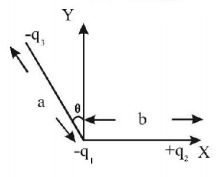Question
Three charges $$ - {q_1}, + {q_2}$$ and $$ - {q_3}$$ are place as shown in the figure. The $$x$$-component of the force on $$ - {q_1}$$ is proportional to
Three charges $$ - {q_1}, + {q_2}$$ and $$ - {q_3}$$ are place as shown in the figure. The $$x$$-component of the force on $$ - {q_1}$$ is proportional to

A.
$$\frac{{{q_2}}}{{{b^2}}} - \frac{{{q_3}}}{{{a^2}}}\cos \theta $$
B.
$$\frac{{{q_2}}}{{{b^2}}} + \frac{{{q_3}}}{{{a^2}}}\sin \theta $$
C.
$$\frac{{{q_2}}}{{{b^2}}} + \frac{{{q_3}}}{{{a^2}}}\cos \theta $$
D.
$$\frac{{{q_2}}}{{{b^2}}} - \frac{{{q_3}}}{{{a^2}}}\sin \theta $$
Answer :
$$\frac{{{q_2}}}{{{b^2}}} + \frac{{{q_3}}}{{{a^2}}}\sin \theta $$
Solution :
Force on charge $${{q_1}}$$ due to $${{q_2}}$$ is
$${F_{12}} = k\frac{{{q_1}{q_2}}}{{{b^2}}}$$
Force on charge $${{q_1}}$$ due to $${{q_3}}$$ is
$${F_{13}} = k\frac{{{q_1}{q_3}}}{{{a^2}}}$$
The $$X$$- component of the force $$\left( {{F_x}} \right)$$ on $${q_1}$$ is $${F_{12}} + {F_{13}}\sin \theta $$
$$\eqalign{ & \therefore {F_x} = k\frac{{{q_1}{q_2}}}{{{b^2}}} + k\frac{{{q_1}{q_2}}}{{{a^2}}}\sin \theta \cr & \therefore {F_x} \propto \frac{{{q_2}}}{{{b^2}}} + \frac{{{q_3}}}{{{a^2}}}\sin \theta \cr} $$
Force on charge $${{q_1}}$$ due to $${{q_2}}$$ is
$${F_{12}} = k\frac{{{q_1}{q_2}}}{{{b^2}}}$$
Force on charge $${{q_1}}$$ due to $${{q_3}}$$ is
$${F_{13}} = k\frac{{{q_1}{q_3}}}{{{a^2}}}$$
The $$X$$- component of the force $$\left( {{F_x}} \right)$$ on $${q_1}$$ is $${F_{12}} + {F_{13}}\sin \theta $$
$$\eqalign{ & \therefore {F_x} = k\frac{{{q_1}{q_2}}}{{{b^2}}} + k\frac{{{q_1}{q_2}}}{{{a^2}}}\sin \theta \cr & \therefore {F_x} \propto \frac{{{q_2}}}{{{b^2}}} + \frac{{{q_3}}}{{{a^2}}}\sin \theta \cr} $$

